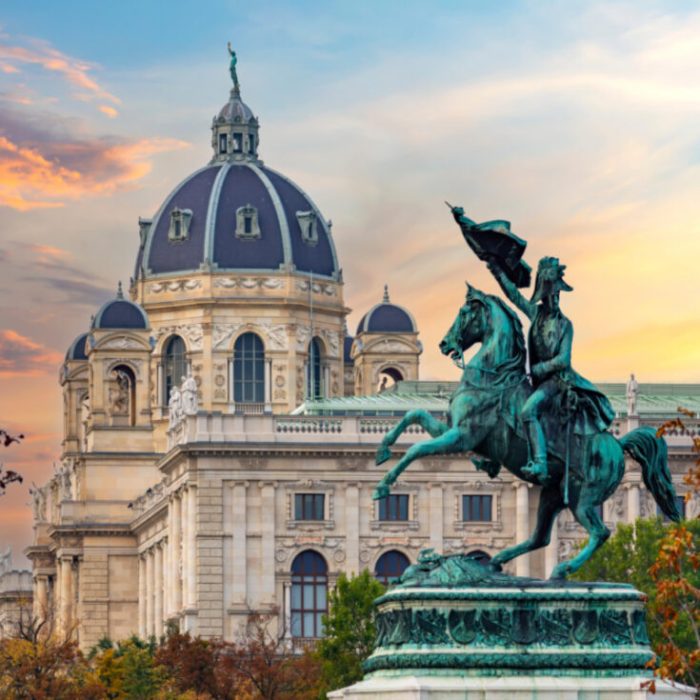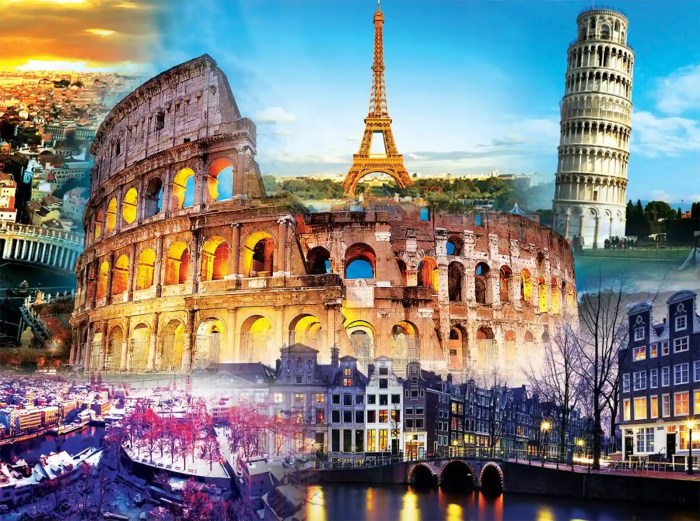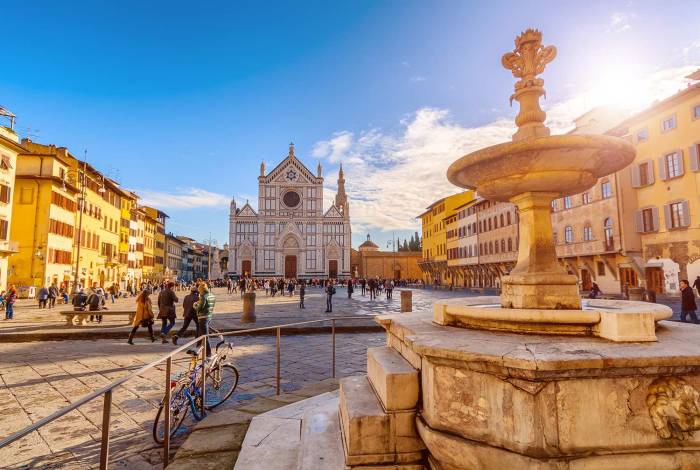As cultural tours in Europe take center stage, this opening passage beckons readers with casual formal language style into a world crafted with good knowledge, ensuring a reading experience that is both absorbing and distinctly original.
Delving into the rich tapestry of Europe’s cultural heritage, this discourse explores the profound impact of historical landmarks, vibrant arts, delectable cuisines, architectural wonders, and captivating performing arts. Prepare to embark on an immersive journey that unveils the essence of Europe’s cultural treasures.
Cultural Heritage and History

Europe boasts a diverse cultural heritage shaped by centuries of civilization, from ancient empires to modern nation-states. This rich tapestry of cultures has left an enduring legacy of historical landmarks, museums, and monuments that attract millions of tourists each year.
UNESCO World Heritage Sites play a pivotal role in promoting cultural tourism. These designated sites recognize and protect the most significant cultural and natural landmarks around the globe. In Europe, there are over 500 UNESCO World Heritage Sites, including iconic landmarks like the Eiffel Tower, the Acropolis, and the Colosseum.
Immerse yourself in Europe’s rich cultural tapestry with captivating tours that unveil historical treasures and architectural marvels. For a rejuvenating respite, escape to the sun-kissed shores of luxury beach resorts , where pristine sands and crystal-clear waters beckon you to unwind.
Return refreshed to continue your cultural exploration, delving deeper into Europe’s captivating past and vibrant present.
Historical Landmarks
Europe is home to countless historical landmarks that offer a glimpse into the continent’s past. From the Roman Colosseum to the medieval castles of Germany, these sites provide a tangible connection to the people and events that have shaped European history.
Museums, Cultural tours in Europe
Europe’s museums house some of the world’s most renowned collections of art, history, and culture. The Louvre in Paris, the British Museum in London, and the Uffizi Gallery in Florence are just a few examples of the many world-class museums that attract visitors from around the globe.
Monuments
Monuments commemorate important historical events and figures. The Arc de Triomphe in Paris honors the victories of the French army, while the Brandenburg Gate in Berlin symbolizes German reunification. These monuments serve as powerful reminders of the past and inspire visitors to reflect on the events that shaped Europe.
Arts and Culture

Europe is a melting pot of artistic and cultural traditions, with a rich history that has shaped the continent’s creative landscape. From the Renaissance masters to the modern art movements, Europe has been at the forefront of artistic innovation for centuries.
Today, the arts and culture scene in Europe is as vibrant as ever, with major art movements continuing to influence contemporary art and design. From the Louvre in Paris to the Uffizi Gallery in Florence, Europe’s museums and galleries house some of the world’s most famous and iconic works of art.
Famous Museums, Galleries, and Theaters
- The Louvre, Paris, France: Home to the Mona Lisa, Venus de Milo, and other masterpieces.
- The Uffizi Gallery, Florence, Italy: Houses a vast collection of Renaissance art, including works by Botticelli, Michelangelo, and Raphael.
- The Hermitage Museum, St. Petersburg, Russia: One of the largest and most comprehensive art museums in the world, with a collection spanning from ancient Egypt to modern art.
- The British Museum, London, UK: A world-renowned museum with a vast collection of artifacts and treasures from around the globe.
- The Prado Museum, Madrid, Spain: Houses a world-class collection of Spanish art, including works by Goya, El Greco, and Velazquez.
- The Royal Opera House, London, UK: One of the world’s leading opera houses, hosting a variety of productions throughout the year.
- The La Scala Opera House, Milan, Italy: Another world-renowned opera house, known for its prestigious productions and performances.
Cultural Events, Festivals, and Exhibitions
In addition to its world-class museums and galleries, Europe also hosts a wide range of cultural events, festivals, and exhibitions throughout the year. These events provide a unique opportunity to experience the continent’s rich cultural heritage and contemporary art scene.
- The Venice Biennale, Venice, Italy: A prestigious international art exhibition held every two years, showcasing the latest trends in contemporary art.
- The Edinburgh Fringe Festival, Edinburgh, Scotland: The world’s largest arts festival, featuring a wide range of theater, comedy, dance, and music performances.
- The Cannes Film Festival, Cannes, France: One of the most prestigious film festivals in the world, showcasing the latest films from around the globe.
- The Oktoberfest, Munich, Germany: The world’s largest beer festival, attracting millions of visitors each year.
- The Glastonbury Festival, Somerset, UK: A legendary music festival featuring a diverse lineup of artists from around the world.
Culinary Delights: Cultural Tours In Europe
Europe is a culinary paradise, boasting a diverse tapestry of flavors, aromas, and traditions. From the succulent seafood of the Mediterranean to the hearty stews of Central Europe, each region offers a unique gastronomic experience that reflects its history, culture, and geography. Culinary tourism is a thriving industry in Europe, allowing visitors to immerse themselves in the local food scene and savor the authentic tastes of each destination.
Local Cuisines and Regional Specialties
Each European country has its own distinct culinary identity, shaped by centuries of tradition and influenced by neighboring cultures. In France, fine dining is an art form, with renowned restaurants showcasing innovative dishes that combine classic techniques with modern flair. Italy is famous for its pasta, pizza, and gelato, while Spain is known for its tapas and paella. Germany offers hearty dishes like sauerkraut and schnitzel, while Greece delights with its fresh seafood and Mediterranean flavors.
Renowned Restaurants
Europe is home to some of the world’s most celebrated restaurants, awarded with Michelin stars for their exceptional cuisine and service. These culinary temples offer unforgettable dining experiences, showcasing the talents of renowned chefs who push the boundaries of gastronomy. From the molecular gastronomy of El Bulli in Spain to the traditional French fare of Le Bernardin in New York, these restaurants are destinations in themselves, attracting food enthusiasts from around the globe.
Cultural tours in Europe often include visits to UNESCO World Heritage Sites , which are recognized for their outstanding cultural or natural significance. These sites offer a glimpse into the rich history and diverse cultures of Europe, from ancient ruins and medieval castles to stunning natural landscapes.
Exploring these UNESCO World Heritage Sites during a cultural tour enriches the experience, providing a deeper understanding of the region’s cultural heritage and its impact on European society.
Culinary Tours and Cooking Classes
For those seeking an immersive culinary experience, Europe offers a wide range of culinary tours and cooking classes. These experiences allow visitors to delve into the local food culture, learn about traditional cooking techniques, and savor the flavors of the region. Participants can visit local markets, meet with producers, and prepare authentic dishes under the guidance of experienced chefs.
Food Markets
Food markets are a vibrant part of European life, offering a glimpse into the culinary traditions of each region. From the bustling Borough Market in London to the colorful La Boqueria in Barcelona, these markets showcase a dazzling array of fresh produce, artisanal cheeses, cured meats, and street food. Visitors can sample local delicacies, interact with vendors, and experience the lively atmosphere of these culinary hubs.
Architecture and Design
Embark on an architectural odyssey through Europe, where ancient ruins and modern masterpieces stand side by side. Witness the transformative influence of architectural styles and movements that have shaped the continent’s urban landscapes. From towering cathedrals to innovative skyscrapers, Europe offers a captivating showcase of architectural brilliance.
The architectural legacy of Europe spans centuries, with iconic structures that have become symbols of their respective cities. From the Parthenon in Athens to the Sagrada Familia in Barcelona, these architectural wonders continue to inspire awe and admiration. Explore the influence of Gothic, Renaissance, Baroque, and Art Nouveau styles, which have left an indelible mark on European architecture.
Ancient Ruins
- Colosseum, Rome: An iconic amphitheater that hosted gladiatorial contests and public spectacles.
- Acropolis, Athens: The sacred citadel of ancient Athens, featuring the Parthenon and other temples.
- Pompeii, Italy: A preserved Roman city buried by volcanic ash, providing a glimpse into ancient life.
Medieval Architecture
- Notre Dame Cathedral, Paris: A Gothic masterpiece known for its intricate stained glass windows and soaring spires.
- St. Peter’s Basilica, Vatican City: A colossal Renaissance basilica, the largest church in the world.
- Prague Castle, Prague: A sprawling complex that includes Gothic, Renaissance, and Baroque elements.
Modern Architecture
- Eiffel Tower, Paris: A wrought-iron lattice tower that has become a symbol of France.
- Guggenheim Museum, Bilbao: A titanium-clad museum designed by Frank Gehry, renowned for its innovative form.
- The Shard, London: A skyscraper designed by Renzo Piano, offering panoramic views of the city.
Music and Performing Arts

Europe boasts a vibrant music and performing arts scene, spanning from classical masterpieces to contemporary performances that captivate audiences. The continent is home to world-renowned concert halls, opera houses, and theaters, where music and performing arts thrive.
Classical music has a strong presence in Europe, with many cities hosting prestigious orchestras and chamber ensembles. From the Vienna Philharmonic to the Berlin Philharmonic, these ensembles perform in historic venues such as the Musikverein in Vienna and the Philharmonie in Berlin.
Opera
Opera is another beloved art form in Europe. The continent is dotted with iconic opera houses, including the Teatro alla Scala in Milan, the Royal Opera House in London, and the Palais Garnier in Paris. These venues host renowned opera companies that stage productions ranging from classic works by Verdi and Puccini to contemporary compositions.
Contemporary Performing Arts
Europe’s contemporary performing arts scene is equally vibrant. Cities like London, Paris, and Berlin are hubs for experimental theater, dance, and performance art. Venues such as the Barbican Centre in London, the Théâtre de la Ville in Paris, and the Volksbühne in Berlin showcase cutting-edge productions that push artistic boundaries.
Music Festivals
Europe hosts a multitude of music festivals that celebrate diverse musical genres. From the Glastonbury Festival in the UK to the Sziget Festival in Hungary, these events bring together artists and music lovers from around the world. They offer a unique opportunity to experience a wide range of musical styles, from rock and pop to folk and electronic music.
While cultural tours in Europe offer an immersive experience into the continent’s rich history and traditions, adrenaline seekers might prefer the thrill of extreme sports vacations. From skiing down the Swiss Alps to kayaking through the Norwegian fjords, Europe caters to those seeking an exhilarating adventure.
However, after a day of pushing limits, cultural tours in Europe provide a welcome respite, allowing visitors to delve into the region’s captivating art, architecture, and cuisine.
Sustainable Cultural Tourism

Sustainable cultural tourism practices are vital to preserve Europe’s cultural heritage. Responsible tourism minimizes negative environmental and socio-economic impacts, ensuring the long-term preservation of cultural assets for future generations.
Responsible tourism initiatives include:
- Minimizing carbon footprint through eco-friendly transportation and accommodation.
- Supporting local businesses that prioritize sustainability and cultural preservation.
- Educating tourists about responsible behavior and the importance of respecting cultural heritage.
Role of Local Communities
Local communities play a crucial role in promoting sustainable cultural tourism by:
- Preserving cultural traditions and practices.
- Participating in tourism development and decision-making.
- Educating tourists about local culture and environmental conservation.
Sustainable cultural tourism ensures that Europe’s rich cultural heritage is preserved while fostering economic development and promoting cross-cultural understanding.
Last Word

In conclusion, cultural tours in Europe offer an unparalleled opportunity to delve into the continent’s diverse and captivating cultural heritage. From ancient ruins to modern masterpieces, from culinary delights to musical extravaganzas, Europe beckons travelers to immerse themselves in a symphony of experiences that will linger long after their return.
Detailed FAQs
What is the significance of UNESCO World Heritage Sites in cultural tourism?
UNESCO World Heritage Sites are recognized for their outstanding universal value and play a crucial role in promoting cultural tourism. They serve as beacons of cultural significance, attracting visitors from around the globe to witness and appreciate the world’s most treasured cultural and natural landmarks.
How can I find information about cultural events and festivals in Europe?
There are numerous online resources and local tourism boards that provide up-to-date information about cultural events and festivals in Europe. Additionally, consulting travel guides and social media platforms can help you discover hidden gems and tailor your itinerary to your specific interests.
What are some tips for sustainable cultural tourism?
To practice sustainable cultural tourism, consider choosing eco-friendly transportation options, supporting local businesses, respecting cultural norms and traditions, and minimizing your environmental impact. By adopting responsible tourism practices, you can contribute to preserving Europe’s cultural heritage for generations to come.